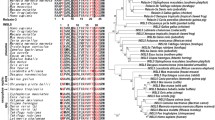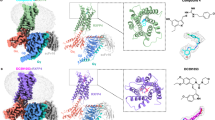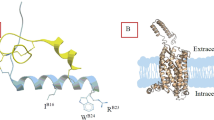Abstract
The insulin superfamily is a group of homologous proteins that are further divided into the insulin family and relaxin family according to their distinct receptors. All insulin superfamily members contain three absolutely conserved disulfide linkages and a nonchiral Gly residue immediately following the first B-chain cysteine. The functionality of this conserved Gly residue in the insulin family has been studied by replacing it with natural l-amino acids or the corresponding unnatural d-amino acids. However, such analysis has not been conducted on relaxin family members. In the present study, we conducted chiral mutagenesis on the conserved B11Gly of the chimeric relaxin family peptide R3/I5, which is an efficient agonist for receptor RXFP3 and RXFP4. Similar to the effects on insulin family foldability, l-Ala or l-Ser substitution completely abolished the in vitro refolding of a recombinant R3/I5 precursor; whereas, d-Ala or d-Ser substitution had no detrimental effect on refolding of a semi-synthetic R3/I5 precursor, suggesting that the conserved Gly residue controls the foldability of relaxin family members. In contrast to the effect on insulin family activity, d-Ala or d-Ser replacement had no detrimental effect on the binding and activation potencies of the mature R3/I5 towards both RXFP3 and RXFP4, suggesting that the conserved Gly residue is irrelevant to the relaxin family’s activity. The present study revealed functionality of the conserved B-chain Gly residue for a relaxin family peptide for the first time, providing an overview of its contribution to foldability and activity of the insulin superfamily.




Similar content being viewed by others
References
Avital-Shmilovici M, Whittaker J, Weiss MA, Kent SB (2014) Deciphering a molecular mechanism of neonatal diabetes mellitus by the chemical synthesis of a protein diastereomer, [d-AlaB8]human proinsulin. J Biol Chem 289:23683–23692
Bailey JL, Cole RD (1959) Studies on the reaction of sulfite with proteins. J Biol Chem 234:1733–1739
Chang X, Jorgensen AM, Bardrum P, Led JJ (1997) Solution structures of the R6 human insulin hexamer. Biochemistry 36:9409–9422
Guo ZY, Tang YH, Wang S, Feng YM (2003) Contribution of the absolutely conserved B8Gly to the foldability of insulin. Biol Chem 384:805–809
Guo ZY, Zhang Z, Jia XY, Tang YH, Feng YM (2005) Mutational analysis of the absolutely conserved B8Gly: consequence on foldability and activity of insulin. Acta Biochim Biophys Sin (Shanghai) 37:673–679
Halls ML, Bathgate RA, Sutton SW, Dschietzig TB, Summers RJ (2015) International Union of Basic and Clinical Pharmacology. XCV. Recent advances in the understanding of the pharmacology and biological roles of relaxin family peptide receptors 1-4, the receptors for relaxin family peptides. Pharmacol Rev 67:389–440
Haugaard-Jönsson LM, Hossain MA, Daly NL, Bathgate RA, Wade JD, Craik DJ, Rosengren KJ (2008) Structure of the R3/I5 chimeric relaxin peptide, a selective GPCR135 and GPCR142 agonist. J Biol Chem 283:23811–23818
Hossain MA, Wade JD (2017) Novel methods for the chemical synthesis of insulin superfamily peptides and of analogues containing disulfide isosteres. Acc Chem Res 50:2116–2127
Hu MJ, Shao XX, Wang JH, Wei D, Guo YQ, Liu YL, Xu ZG, Guo ZY (2016a) Mechanism for insulin-like peptide 5 distinguishing the homologous relaxin family peptide receptor 3 and 4. Sci Rep 6:29648
Hu MJ, Shao XX, Wang JH, Wei D, Liu YL, Xu ZG, Guo ZY (2016b) Identification of hydrophobic interactions between relaxin-3 and its receptor RXFP3: implication for a conformational change in the B-chain C-terminus during receptor binding. Amino Acids 48:2227–2236
Hu MJ, Wei D, Shao XX, Wang JH, Liu YL, Xu ZG, Guo ZY (2017) Interaction mechanism of insulin-like peptide 5 with relaxin family peptide receptor 4. Arch Biochem Biophys 619:27–34
Hu MJ, Shao XX, Li HZ, Nie WH, Wang JH, Liu YL, Xu ZG, Guo ZY (2018) Development of a novel ligand binding assay for relaxin family peptide receptor 3 and 4 using NanoLuc complementation. Amino Acids 50:1111–1119
Hua QX, Nakagawa S, Hu SQ, Jia W, Wang S, Weiss MA (2006) Toward the active conformation of insulin: stereospecific modulation of a structural switch in the B chain. J Biol Chem 281:24900–24909
Hua QX, Jia W, Weiss MA (2011) Conformational dynamics of insulin. Front Endocrinol (Lausanne) 2:48
Kadima W (1999) Role of metal ions in the T- to R-allosteric transition in the insulin hexamer. Biochemistry 38:13443–13452
Liu C, Chen J, Kuei C, Sutton S, Nepomuceno D, Bonaventure P, Lovenberg TW (2005) Relaxin-3/insulin-like peptide 5 chimeric peptide, a selective ligand for G protein-coupled receptor (GPCR)135 and GPCR142 over leucine-rich repeat-containing G protein-coupled receptor 7. Mol Pharmacol 67:231–240
Liu Y, Zhang L, Shao XX, Hu MJ, Liu YL, Xu ZG, Guo ZY (2016) A negatively charged transmembrane aspartate residue controls activation of the relaxin-3 receptor RXFP3. Arch Biochem Biophys 604:113–120
Liu F, Li P, Gelfanov V, Mayer J, DiMarchi R (2017) Synthetic advances in insulin-like peptides enable novel bioactivity. Acc Chem Res 50:1855–1865
Luo X, Bathgate RA, Zhang WJ, Liu YL, Shao XX, Wade JD, Guo ZY (2010a) Design and recombinant expression of insulin-like peptide 5 precursors and the preparation of mature human INSL5. Amino Acids 39:1343–1352
Luo X, Liu YL, Layfield S, Shao XX, Bathgate RA, Wade JD, Guo ZY (2010b) A simple approach for the preparation of mature human relaxin-3. Peptides 31:2083–2088
Nakagawa SH, Zhao M, Hua QX, Hu SQ, Wan ZL, Jia W, Weiss MA (2005) Chiral mutagenesis of insulin. Foldability and function are inversely regulated by a stereospecific switch in the B chain. Biochemistry 44:4984–4999
Nilsson J, Jonasson P, Samuelsson E, Ståhl S, Uhlén M (1996) Integrated production of human insulin and its C-peptide. J Biotechnol 48:241–250
Rosengren KJ, Lin F, Bathgate RA, Tregear GW, Daly NL, Wade JD, Craik DJ (2006) Solution structure and novel insights into the determinants of the receptor specificity of human relaxin-3. J Biol Chem 281:5845–5851
Sohma Y, Pentelute BL, Whittaker J, Hua QX, Whittaker LJ, Weiss MA, Kent SB (2008) Comparative properties of insulin-like growth factor 1 (IGF-1) and [Gly7d-Ala]IGF-1 prepared by total chemical synthesis. Angew Chem Int Ed Engl 47:1102–1106
Tikhonov RV, Pechenov SE, Belacheu IA, Yakimov SA, Klyushnichenko VE, Boldireva EF, Korobko VG, Tunes H, Thiemann JE, Vilela L, Wulfson AN (2001) Recombinant human insulin. VIII. Isolation of fusion protein–S-sulfonate, biotechnological precursor of human insulin, from the biomass of transformed Escherichia coli cells. Protein Expr Purif 21:176–182
Tsumoto K, Umetsu M, Kumagai I, Ejima D, Philo JS, Arakawa T (2004) Role of arginine in protein refolding, solubilization, and purification. Biotechnol Prog 20:1301–1308
Tsumoto K, Ejima D, Kita Y, Arakawa T (2005) Review: why is arginine effective in suppressing aggregation? Protein Pept Lett 12:613–619
Wang JH, Shao XX, Hu MJ, Wei D, Liu YL, Xu ZG, Guo ZY (2017a) A novel BRET-based binding assay for interaction studies of relaxin family peptide receptor 3 with its ligands. Amino Acids 49:895–903
Wang JH, Shao XX, Hu MJ, Wei D, Nie WH, Liu YL, Xu ZG, Guo ZY (2017b) Rapid preparation of bioluminescent tracers for relaxin family peptides using sortase-catalysed ligation. Amino Acids 49:1611–1617
Wang JH, Hu MJ, Shao XX, Wei D, Liu YL, Xu ZG, Guo ZY (2018a) Cholesterol modulates the binding properties of human relaxin family peptide receptor 3 with its ligands. Arch Biochem Biophys 646:24–30
Wang JH, Hu MJ, Zhang L, Shao XX, Lv CH, Liu YL, Xu ZG, Guo ZY (2018b) Exploring receptor selectivity of the chimeric relaxin family peptide R3/I5 by incorporating unnatural amino acids. Biochimie 154:77–85
Wei D, Hu MJ, Shao XX, Wang JH, Nie WH, Liu YL, Xu ZG, Guo ZY (2017) Development of a selective agonist for relaxin family peptide receptor 3. Sci Rep 7:3230
Zhang WJ, Jiang Q, Wang XY, Song G, Shao XX, Guo ZY (2013) A convenient method for europium-labeling of a recombinant chimeric relaxin family peptide R3/I5 for receptor-binding assays. J Pept Sci 19:350–354
Acknowledgements
This work was supported by Grants from the National Natural Science Foundation of China (CN) (31670773, 31470767).
Author information
Authors and Affiliations
Corresponding author
Ethics declarations
Conflict of interest
The authors declare that they have no conflict of interest.
Research involving human participants and/or animals
This article does not contain any studies with human participants or animals performed by any of the authors.
Additional information
Handling Editor: N. Sewald.
Publisher's Note
Springer Nature remains neutral with regard to jurisdictional claims in published maps and institutional affiliations.
Rights and permissions
About this article
Cite this article
Wang, JH., Shao, XX., Hu, MJ. et al. Functionality of an absolutely conserved glycine residue in the chimeric relaxin family peptide R3/I5. Amino Acids 51, 619–626 (2019). https://doi.org/10.1007/s00726-018-02694-y
Received:
Accepted:
Published:
Issue Date:
DOI: https://doi.org/10.1007/s00726-018-02694-y




